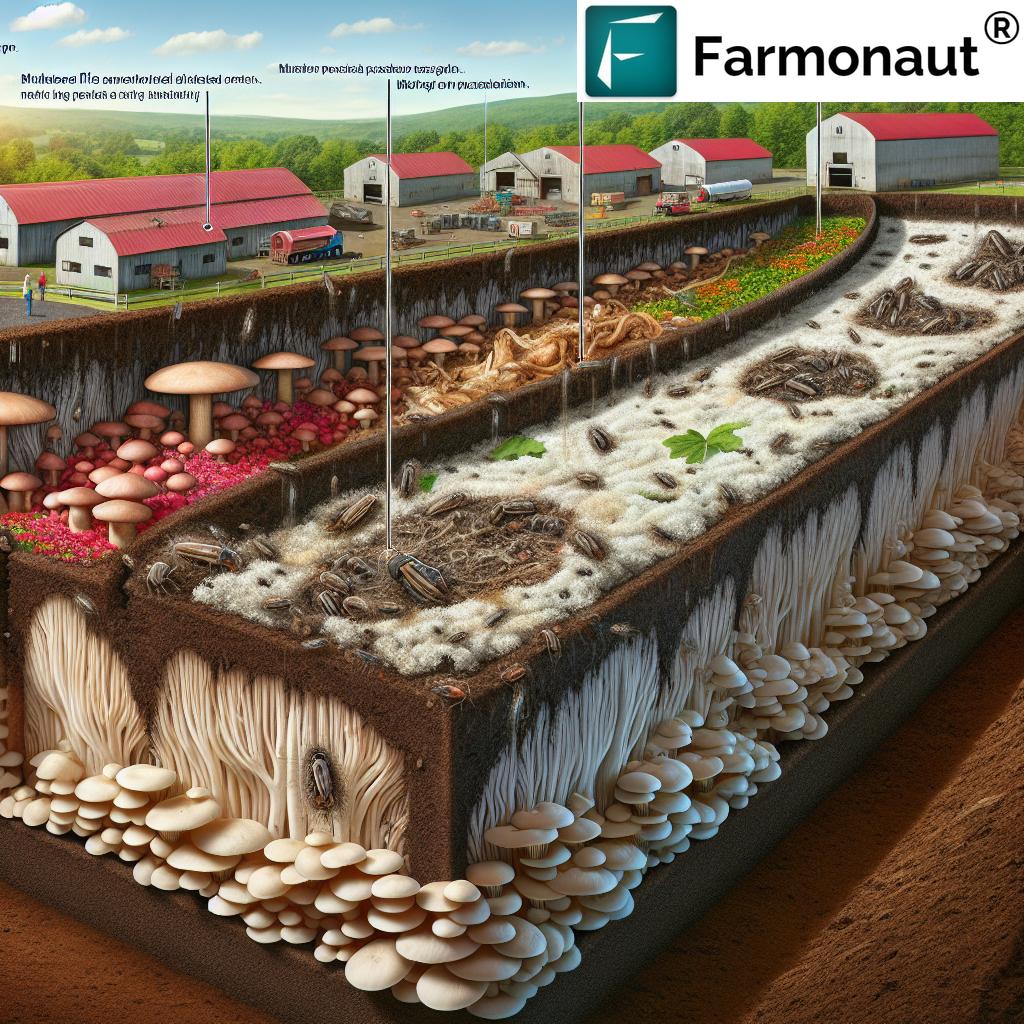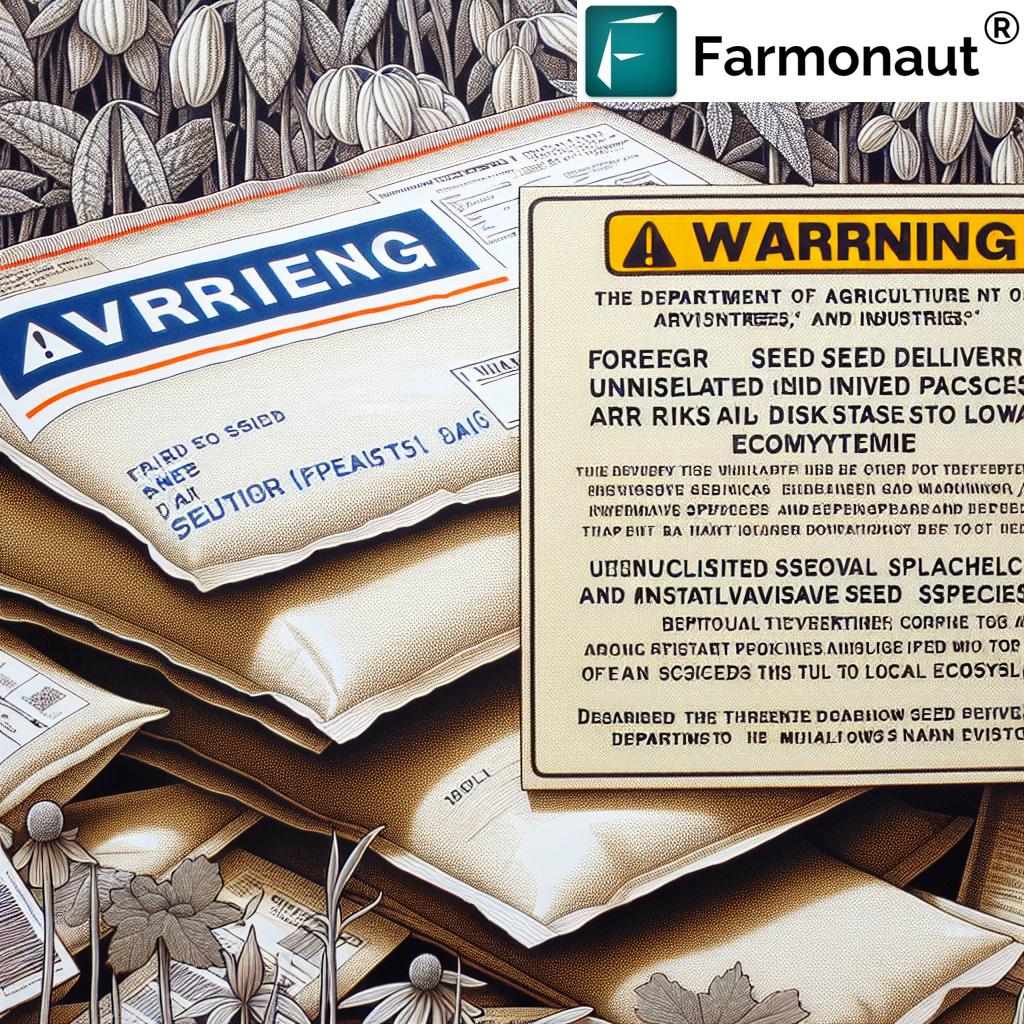Pennsylvania Mushroom Phorid Fly Crisis: 7 Solutions
Table of Contents
- Overview: Understanding the Mushroom Phorid Fly Crisis
- Economic and Social Impacts of the Phorid Fly Infestation in Pennsylvania
- Historical Context and Regulatory Challenges
- 7 Solutions to Combat the Mushroom Phorid Fly Crisis
- Solution Comparison Table
- Community Engagement and Support Measures
- Government Actions, Quarantine Orders, and Funding
- Challenges and the Future Outlook for Mushroom Pest Management in Pennsylvania
- Farmonaut: Precision Agriculture Support for Pest Management
- FAQ: Pennsylvania Mushroom Phorid Fly Crisis
- Conclusion
“In 2023, phorid fly infestations impacted over 60% of Pennsylvania’s commercial mushroom farms.”
The Mushroom Phorid Fly Crisis: An Urgent Threat to Pennsylvania’s Agriculture
The mushroom industry is a cornerstone of Pennsylvania’s agricultural economy, with vast stretches of mushroom houses—especially in Chester County—making our state the undisputed capital of American mushroom cultivation. However, this industry now faces a significant crisis: the mushroom phorid fly (Megaselia halterata). This persistent pest not only threatens crop yields but also impacts our communities, affecting the quality of life for residents living near mushroom operations.
Early, effective interventions are critical for all stakeholders—growers, residents, policymakers, and the wider agricultural community—to safeguard livelihoods and the environment. In this guide, we’ll detail the impact of phorid flies on agriculture, review associated challenges, and—most importantly—present seven actionable, sustainable solutions to the Pennsylvania mushroom phorid fly crisis.
“One phorid fly female can lay up to 750 eggs, rapidly escalating infestations in mushroom-growing facilities.”
Mushroom Phorid Fly: Species Overview & Life Cycle
Understanding the biology of the mushroom phorid fly (Megaselia halterata) is key to effective control. This small, hump-backed species thrives in the warm, humid environments of mushroom cultivation.
Adult flies (adults) live only a few days and do not feed. Their sole purposes are to mate and lay eggs on mushroom beds or in compost teeming with actively growing mycelium. Within days, the eggs hatch into larvae, which begin feeding on the vital fungal mycelium:
- Each adult female lays hundreds of eggs during her brief lifespan.
- Larvae feed voraciously, destroying the growing mycelium and directly damaging crops.
- The entire cycle (egg to adult) is fast—about 20 to 30 days.
The phorid fly infestation in Pennsylvania has escalated due to these rapid reproductive rates and favorable environmental conditions in mushroom-growing areas.

How Phorid Flies Thrive in Mushroom Houses
Phorid flies are specially adapted for high-humidity, nutrient-rich environments. We see that densely packed mushroom houses, with ample compost beds, provide everything these pests need to complete their lifecycle. The combination of rapid larval development and limited predator pressure makes phorid fly populations capable of overwhelming even the best-managed farms if not checked in time.
Primary Factors Leading to Mushroom Phorid Fly Outbreaks
- High humidity and warmth in mushroom-growing environments
- Abundant decomposing organic matter (mushroom compost/mycelium)
- Absence of effective natural predators
- Regulatory changes limiting chemical control options
- Inefficient sanitation and variable structural designs of farming facilities
Left unchecked, a single generation can multiply into millions, threatening mushroom yields and causing community-wide nuisance and distress across southeastern Pennsylvania.
Economic and Social Impacts of the Phorid Fly Infestation in Pennsylvania
The mushroom phorid fly crisis carries far-reaching implications for both agriculture and local communities in the state. Its direct and indirect effects put major pressure on the livelihood of farmers, the stability of agricultural economy, and the general well-being of Chester County and surrounding regions.
Economic Impact of Phorid Flies
- Crop Losses: Up to 40% of mushroom yields can be destroyed by unchecked infestations, resulting in substantial financial losses for growers and threatening farm viability.
- Industry Value: Chester County alone boasts about 2,000 commercial mushroom houses, making Pennsylvania the #1 mushroom producer in the US—a major contributor to the state’s economy.
- Increased Costs: Implementing emergency pest control measures and maintaining best practices require significant investment.
- Regulatory and Production Delays: Quarantine orders and government-mandated treatments can slow production, increase operational costs, and pose logistical challenges.
Social and Community Impacts
- Residential Nuisance: Swarms of flies regularly invade homes, disrupting daily activities and damaging quality of life for nearby residents.
- Public Health Concerns: While phorid flies do not transmit diseases to humans, their sheer numbers create psychological and sanitation concerns in affected townships and communities.
- Community Tension: Ongoing infestations can strain relations between growers and residents, prompting calls for more rigorous government action and regulatory change.
Beyond mere inconvenience, the impacts of this pest issue ripple across all facets of our agricultural sector and social fabric, emphasizing the urgent need for collaborative solutions.
“In 2023, phorid fly infestations impacted over 60% of Pennsylvania’s commercial mushroom farms.”
Historical Context and Regulatory Challenges in Managing the Mushroom Phorid Fly
Mushroom growers in Pennsylvania have battled phorid flies since the 1940s. Historically, the industry relied on established chemical controls like diazinon, an organophosphate insecticide known to be effective against this pest. However, due to mounting concerns over toxicity and environmental hazards, the U.S. Environmental Protection Agency banned diazinon in 2012. This regulatory shift removed the main tool used by growers for decades and intensified the challenges of managing phorid flies in mushroom farms.
Our farming community was left seeking sustainable, environmentally responsible solutions—setting the stage for the current focus on integrated pest management (IPM), research, and innovation.

Regulatory Response & Persistent Challenges
- Post-ban Gaps: Absence of effective, sanctioned chemical alternatives led to the rapid spread of infestations in key areas.
- Necessity for Alternatives: Research shifted towards biological control, environmental management, and community engagement.
- Compliance Demands: Any new strategy requires thorough implementation by all growers for broad efficacy—noncompliance leaves entire regions vulnerable.
The regulatory landscape now demands a multifaceted, sustainable approach—addressing not just the flies themselves, but our broader relationship with agricultural environmental stewardship.
7 Effective Solutions for the Pennsylvania Mushroom Phorid Fly Crisis
Safeguarding our state’s mushroom industry, agricultural economy, and the well-being of affected communities requires more than one approach. Through a combination of scientific research, innovative tools, and best practices, we can develop actionable, sustainable solutions for mushroom pests. Below, we outline seven leading strategies to reduce phorid fly populations in Pennsylvania and protect our crops and communities long-term.
1. Biological Control: Natural Predators for Integrated Pest Management
As chemical options wane, introducing biological controls emerges as a potent, eco-friendly strategy in integrated pest management for mushrooms. Key measures include:
- Entomopathogenic Nematodes: These microscopic roundworms, once introduced into mushroom beds, actively seek and destroy phorid fly larvae—curbing future generations.
- Predatory Mites: Deployed as natural enemies, these beneficial arthropods prey on phorid eggs and larvae, disrupting the pest’s reproductive cycle.
Proper application ensures minimal impact on crops, aligning well with sustainable pest management goals and providing growers with viable, long-term options for managing phorid flies in mushroom farms.
Example:
By releasing entomopathogenic nematodes after steaming off rooms, growers can achieve significant reductions in subsequent fly populations with less reliance on synthetic chemicals.
2. Chemical Control: Eco-friendly Biopesticides and Targeted Applications
With diazinon phased out, mushroom pest control strategies now revolve around biopesticides:
- Botanical-Based Solutions: Products like EcoVia utilize botanical oils, providing rapid knockdown of adult flies with minimal residue and reduced environmental footprint.
-
Electrostatic Screens: Application of these oils onto screens strategically
placed in mushroom houses physically traps and kills incoming flies—integrating chemical and mechanical controls.
While not universally effective on their own, eco-friendly biopesticides play an integral role in a comprehensive, integrated control program.
3. Cultural and Environmental Control: Sanitation and Compost Management
Environmental and operational adjustments can break the reproductive cycle of phorid flies:
- Best Management Practices (BMPs): Regularly removing waste, maintaining clean compost areas, and limiting organic debris directly reduces breeding sites.
- Proper Composting: Ensuring compost is fully mature and free of excess moisture reduces favorable conditions for egg-laying and larval survival.
- Sealed Structures: Upgrading doors, installing fly-proof screens, and sealing building cracks limit access and prevent invasions into homes and further mushroom-producing areas.
These environmental management practices are foundational in managing phorid flies on mushroom farms and require strong daily discipline from farm staff.
4. Heat Treatment: Steaming Off for Immediate Population Reduction
Heat treatment—or “steaming off”—is a direct, highly effective method used to control phorid fly populations:
- Application: Rooms and compost piles are subjected to high temperatures (140°F/60°C or greater) for several hours, killing all life stages of the fly (egg, larva, adult).
- Government Orders: The Pennsylvania Department of Agriculture mandates steaming procedures in outbreak zones (e.g., New Garden and Kennett Township, Chester County).
This method provides rapid, short-term relief from heavy infestations and is often a required quarantine action during significant outbreaks.
Resource:
Our carbon footprinting solution supports mushroom growers in monitoring the energy input and environmental impact of heat treatments—enabling smarter, more sustainable resource deployment over time.
5. Physical Barriers: Mechanical Exclusion Tactics
To defend both crops and residential areas, farms are implementing robust physical barriers:
- Fly Screens and Air Curtains: Installing fine-mesh screens over vents, windows, and doors physically excludes flies from mushroom houses.
- Electrostatic Panels: These use static charge to attract and immobilize adult flies, especially when combined with targeted biopesticides.
- Double Door Entryways: Creating “airlocks” minimizes unintentional introduction of pests during frequent entries and exits.
Such mechanical exclusion methods underpin effective sustainable solutions for mushroom pests—protecting yields and quality for both growers and residents.
6. Community Engagement & Education
Phorid fly management extends beyond farm boundaries: residents, extension experts, and governments all play a part. Collaborative efforts in affected townships and communities include:
- Outreach Programs: Penn State Extension’s phorid-fly liaison provides information, technical support, and short-term measures to alleviate the nuisance for homeowners and neighborhoods.
- Tailored Communication: Open, ongoing dialogue ensures residents understand both the challenge and the steps being taken to resolve it, reducing tension and fostering patience during intense outbreak periods.
- Complaint Resources: Formal channels for logging and addressing fly-related household issues further empower affected communities.
A strong, well-informed community is better equipped to advocate for sustainable, science-driven solutions while supporting the mushroom industry’s economic and cultural significance in the state.
7. Research-Driven Integrated Pest Management (IPM) Programs
The final pillar is ongoing collaborative research and the regular implementation of integrated pest management for mushrooms. These dynamic IPM strategies combine biological, cultural, mechanical, and chemical controls, refined through real-time data collection and experimentation.
- Monitoring with Technology: Implementation of remote crop health monitoring—like satellite imaging—yields data on pest pressure hotspots, supporting targeted interventions for maximum efficacy and minimal cost.
- Continuous Education: Training and updating all stakeholders (growers, staff, extension agents) on new findings ensures rapid adaptation and resilience as pest behaviors evolve.
- Compliance Checks: Enforcing mandatory protocols across all operations is essential. Incomplete compliance renders multi-farm communities vulnerable to re-infestation—necessitating both regulatory oversight and community willingness.
The Farmonaut platform offers mobile and satellite-based support for monitoring crop health, resource management, and early pest detection, making these IPM strategies more accessible and data-driven for PA growers.
Utilizing tools like the Jeevn AI-based farm advisory system for real-time weather, crop, and pest advisories can give mushroom growers a significant edge in implementing IPM strategies and adapting swiftly to field challenges. Read more about AI-based crop, plantation, and forest advisory for precision pest management.
Solution Comparison Table: Evaluating Phorid Fly Control Strategies
To help stakeholders make informed decisions, we’ve compiled a side-by-side comparison of the top 7 solutions for the mushroom phorid fly crisis. This table summarizes estimated impact, cost, difficulty, and sustainability—distilling key factors in managing phorid flies in mushroom farms.
| Solution Name | Description | Estimated Effectiveness (% Reduction) |
Estimated Cost (per acre/application) |
Implementation Complexity | Sustainability (Short/Long-term) |
|---|---|---|---|---|---|
| Biological Control | Use of predatory mites and beneficial nematodes to target phorid eggs and larvae. | 50–70% | Medium ($150–$400) | Moderate | Long-term |
| Chemical/Biopesticide Control | Botanical oil-based sprays and treated electrostatic screens. | 40–60% | Low–Medium ($60–$200) | Easy–Moderate | Short-term |
| Environmental Control | Sanitation, waste management, and compost optimization to eliminate breeding sites. | 30–50% | Low ($30–$100) | Easy | Long-term |
| Heat Treatment | Steaming-off mushroom rooms and compost with high temperatures. | 80–95% | High ($300–$800) | High | Short-term |
| Physical Barriers | Installation of fly-proof screens, double-door entryways, and air curtains. | 60–75% | Medium ($120–$350) | Moderate | Long-term |
| Community Engagement | Education, outreach, and transparent communication with affected residents. | Varies (supports other measures) | Low ($15–$30) | Easy | Long-term |
| Integrated IPM Programs | Data-driven, combined use of all above measures, tailored per farm/region. | up to 95% | High ($400+) | High | Long-term |
For advanced integration and real-time field monitoring, Pennsylvania mushroom growers and agribusinesses can leverage our Farmonaut Satellite and Weather API—or access developer documentation here—to bring precision data into their management platforms.
Community Engagement: Supporting Residents and Ensuring Transparency
Our commitment to community engagement is central to any successful response to the mushroom phorid fly crisis. Addressing the fly’s impacts beyond the farm is as important as the biology of control.
Measures for Community Support
- Liaison Roles: Extension services employ dedicated personnel to connect researchers, farmers, and residents—providing up-to-date guidance and fielding complaints.
- Public Education: Clear, timely communication and publicly available resources help communities understand regulatory actions, best practices, and what to expect during fly pressure surges.
Only through collaborative dialogue—involving every stakeholder from growers to township officials—can nuisance, anxiety, and social tension be minimized in affected areas like New Garden and Kennett Townships.
Government Initiatives: Quarantine Orders, Funding, and Compliance
State and local government bodies play a pivotal role in enforcing effective mushroom pest management throughout Pennsylvania:
- Quarantine Orders: As seen in Chester County’s outbreak, the Pennsylvania Department of Agriculture now mandates “steaming off” and heat treatment protocols for all mushroom farms within specified crisis zones.
- Financial Support: $500,000 in grant funding has been allocated to help farmers implement control measures—demonstrating the state’s commitment to preserving agricultural livelihoods.
- Compliance and Coordination: Full compliance from every farm is essential. The interconnected nature of mushroom production in Chester County and beyond means even a single outlier can threaten progress.
- Ongoing Research: Funding and institutional partnerships ensure that all strategies—be it biological or physical barriers—receive scientific validation for relevance and sustainability.
State-level intervention and funding are vital to enable our mushroom industry to adapt, recover, and strengthen against future pest invasions.
Benefit:
Our farm fleet and resource management technology makes tracking, scheduling, and compliance with steaming or other mandated treatments easier for commercial farms—helping minimize unnecessary expenses and streamline regulatory reporting.
Challenges and the Future of Mushroom Pest Management in Pennsylvania
Despite strong progress, managing the mushroom phorid fly crisis remains an ongoing challenge in Pennsylvania. Several persistent factors complicate our efforts:
- Diversity in Housing Structures: No two mushroom houses are identical, which means pest management protocols must be customized for different layouts, airflow, and operation schedules.
- Compliance Issues: Universal adherence to quarantine and treatment measures is difficult, but without it, ersatz “safe zones” can harbor and repopulate flies.
- Emergence of Resistance: Overuse of any single solution, whether biological or chemical, may result in reduced efficacy over time—requiring constant innovation and monitoring.
- Balancing Economic & Environmental Costs: Large-scale heat treatments and certain physical upgrades can be costly and energy-intensive.
- Maintaining Community Trust: With residents in affected areas facing persistent nuisance, transparent engagement and rapid response remain crucial for long-term community support.
The path forward lies in adaptive, data-driven approaches, innovative technology solutions, continuous research, and industry-wide collaboration—all working together to sustain Pennsylvania’s vital mushroom economy while safeguarding the interests of our most affected communities.
Farmonaut: Smart Precision Agriculture Tools for Sustainable Mushroom Pest Management
As we implement the latest mushroom pest control strategies, leveraging advanced technology can make our control programs more effective and accessible across Pennsylvania’s mushroom sector.
- Farmonaut provides satellite-based crop health and pest pressure monitoring tools—helping us identify hotspots, track intervention success, and optimize resource use while lowering operational costs.
- Through the Agro-Admin App for large-scale farm management, we enable coordinated record-keeping, compliance, and data-driven decisions—empowering growers to respond quickly to emerging threats.
- The Farmonaut blockchain-based product traceability system ensures transparency throughout the supply chain, boosting consumer and regulatory trust—especially important in regions recovering from fly outbreaks and pest quarantines.
- For growers seeking financing, our satellite crop loan and insurance verification tools offer efficient, low-bias documentation for insurance claims and loan approvals.
- Farmonaut carbon footprinting helps monitor and offset the environmental costs of emergency interventions—positioning the Pennsylvania mushroom industry as a leader in sustainability.
Our solutions are available on Android, iOS, Browser, and via API for seamless integration into operational workflows, making data-driven integrated pest management for mushrooms possible at all scales of production.
Frequently Asked Questions (FAQ): Mushroom Phorid Fly Crisis
What is a mushroom phorid fly and why is it a serious problem in Pennsylvania?
The mushroom phorid fly (Megaselia halterata) is a tiny insect that breeds rapidly in the warm, humid environments typical of mushroom houses, feeding on mycelium and causing substantial crop losses. Recent populations have reached crisis levels in Pennsylvania, threatening the region’s economy and the well-being of local communities.
How do phorid flies impact local residents?
Residents near mushroom farms often experience swarms of flies entering homes and public spaces, creating a persistent nuisance and affecting daily life—making swift community and government action imperative.
What are the main strategies to control and reduce phorid fly infestations?
Seven primary solutions are recommended: biological control agents, eco-friendly biopesticides, strict sanitation, physical exclusion, heat/steam treatments, strong community engagement, and robust, data-driven integrated pest management programs.
Why is 100% compliance among mushroom growers so important?
The interconnectedness of mushroom farms in Pennsylvania means an infestation in one location can easily spread to others. Complete compliance ensures the effectiveness of regional eradication and control efforts.
How can technology help with pest management in mushroom cultivation?
Remote sensing, AI-based advisory, and precise data collection (such as offered by Farmonaut) enable growers to detect problems early, allocate resources efficiently, and document interventions for improved outcomes and regulatory compliance.
Where can I find more information on Farmonaut’s precision agriculture tools?
Explore Farmonaut’s web, Android, or iOS apps for a firsthand experience of our satellite-based farm management solutions.
Conclusion: A Collaborative Path Forward for Pennsylvania’s Mushroom Industry
The mushroom phorid fly crisis underscores the fragile balance between agricultural prosperity, community quality of life, and environmental sustainability. As we’ve explored, Pennsylvania’s mushroom sector has faced—and continues to face—significant challenges from a pest that can devastate crops and disrupt lives.
The seven solution framework—anchored in science, technology, collaboration, and transparency—is our state’s best response to protecting one of America’s most valuable agricultural industries. From biological agents to cutting-edge technology, every solution requires both disciplined on-the-ground practices and strong cooperation across farm, community, and government lines.
As new threats emerge and farming methods evolve, our collective success will depend on stakeholder engagement, compliance with best practices, and a commitment to both economic viability and community well-being. By integrating both traditional wisdom and modern, data-driven agriculture, we can build a more resilient future for everyone affected by the mushroom phorid fly crisis in Pennsylvania.
Let us stay informed, proactive, and united—ensuring that Pennsylvania remains at the forefront of sustainable mushroom production for generations to come.














